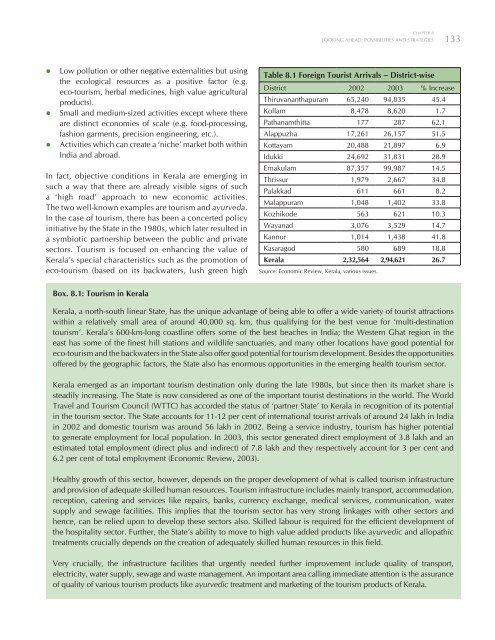Kerala 2005 - of Planning Commission
Kerala 2005 - of Planning Commission
Kerala 2005 - of Planning Commission
You also want an ePaper? Increase the reach of your titles
YUMPU automatically turns print PDFs into web optimized ePapers that Google loves.
CHAPTER 8<br />
LOOKING AHEAD: POSSIBILITIES AND STRATEGIES<br />
133<br />
• Low pollution or other negative externalities but using<br />
the ecological resources as a positive factor (e.g.<br />
eco-tourism, herbal medicines, high value agricultural<br />
products).<br />
• Small and medium-sized activities except where there<br />
are distinct economies <strong>of</strong> scale (e.g. food-processing,<br />
fashion garments, precision engineering, etc.).<br />
• Activities which can create a ‘niche’ market both within<br />
India and abroad.<br />
In fact, objective conditions in <strong>Kerala</strong> are emerging in<br />
such a way that there are already visible signs <strong>of</strong> such<br />
a ‘high road’ approach to new economic activities.<br />
The two well-known examples are tourism and ayurveda.<br />
In the case <strong>of</strong> tourism, there has been a concerted policy<br />
initiative by the State in the 1980s, which later resulted in<br />
a symbiotic partnership between the public and private<br />
sectors. Tourism is focused on enhancing the value <strong>of</strong><br />
<strong>Kerala</strong>’s special characteristics such as the promotion <strong>of</strong><br />
eco-tourism (based on its backwaters, lush green high<br />
Table 8.1 Foreign Tourist Arrivals – District-wise<br />
District 2002 2003 % Increase<br />
Thiruvananthapuram 65,240 94,835 45.4<br />
Kollam 8,478 8,620 1.7<br />
Pathanamthitta 177 287 62.1<br />
Alappuzha 17,261 26,157 51.5<br />
Kottayam 20,488 21,897 6.9<br />
Idukki 24,692 31,831 28.9<br />
Ernakulam 87,357 99,987 14.5<br />
Thrissur 1,979 2,667 34.8<br />
Palakkad 611 661 8.2<br />
Malappuram 1,048 1,402 33.8<br />
Kozhikode 563 621 10.3<br />
Wayanad 3,076 3,529 14.7<br />
Kannur 1,014 1,438 41.8<br />
Kasaragod 580 689 18.8<br />
<strong>Kerala</strong> 2,32,564 2,94,621 26.7<br />
Source: Economic Review, <strong>Kerala</strong>, various issues.<br />
Box. 8.1: Tourism in <strong>Kerala</strong><br />
<strong>Kerala</strong>, a north-south linear State, has the unique advantage <strong>of</strong> being able to <strong>of</strong>fer a wide variety <strong>of</strong> tourist attractions<br />
within a relatively small area <strong>of</strong> around 40,000 sq. km, thus qualifying for the best venue for ‘multi-destination<br />
tourism’. <strong>Kerala</strong>’s 600-km-long coastline <strong>of</strong>fers some <strong>of</strong> the best beaches in India; the Western Ghat region in the<br />
east has some <strong>of</strong> the finest hill stations and wildlife sanctuaries, and many other locations have good potential for<br />
eco-tourism and the backwaters in the State also <strong>of</strong>fer good potential for tourism development. Besides the opportunities<br />
<strong>of</strong>fered by the geographic factors, the State also has enormous opportunities in the emerging health tourism sector.<br />
<strong>Kerala</strong> emerged as an important tourism destination only during the late 1980s, but since then its market share is<br />
steadily increasing. The State is now considered as one <strong>of</strong> the important tourist destinations in the world. The World<br />
Travel and Tourism Council (WTTC) has accorded the status <strong>of</strong> ‘partner State’ to <strong>Kerala</strong> in recognition <strong>of</strong> its potential<br />
in the tourism sector. The State accounts for 11-12 per cent <strong>of</strong> international tourist arrivals <strong>of</strong> around 24 lakh in India<br />
in 2002 and domestic tourism was around 56 lakh in 2002. Being a service industry, tourism has higher potential<br />
to generate employment for local population. In 2003, this sector generated direct employment <strong>of</strong> 3.8 lakh and an<br />
estimated total employment (direct plus and indirect) <strong>of</strong> 7.8 lakh and they respectively account for 3 per cent and<br />
6.2 per cent <strong>of</strong> total employment (Economic Review, 2003).<br />
Healthy growth <strong>of</strong> this sector, however, depends on the proper development <strong>of</strong> what is called tourism infrastructure<br />
and provision <strong>of</strong> adequate skilled human resources. Tourism infrastructure includes mainly transport, accommodation,<br />
reception, catering and services like repairs, banks, currency exchange, medical services, communication, water<br />
supply and sewage facilities. This implies that the tourism sector has very strong linkages with other sectors and<br />
hence, can be relied upon to develop these sectors also. Skilled labour is required for the efficient development <strong>of</strong><br />
the hospitality sector. Further, the State’s ability to move to high value added products like ayurvedic and allopathic<br />
treatments crucially depends on the creation <strong>of</strong> adequately skilled human resources in this field.<br />
Very crucially, the infrastructure facilities that urgently needed further improvement include quality <strong>of</strong> transport,<br />
electricity, water supply, sewage and waste management. An important area calling immediate attention is the assurance<br />
<strong>of</strong> quality <strong>of</strong> various tourism products like ayurvedic treatment and marketing <strong>of</strong> the tourism products <strong>of</strong> <strong>Kerala</strong>.

















